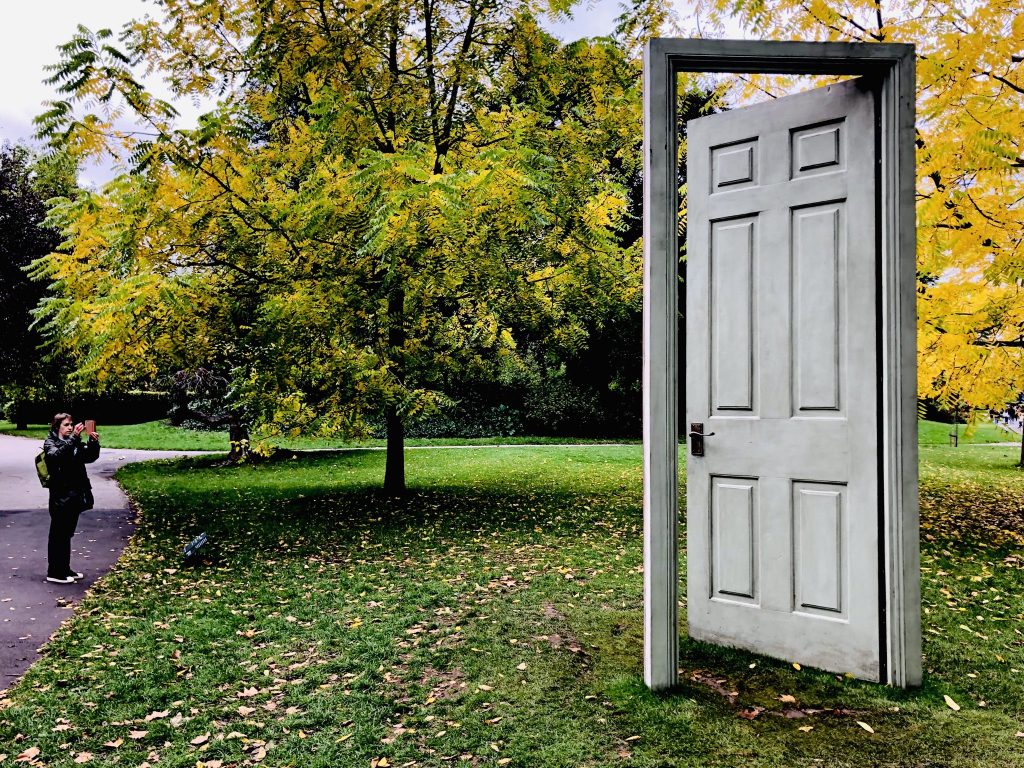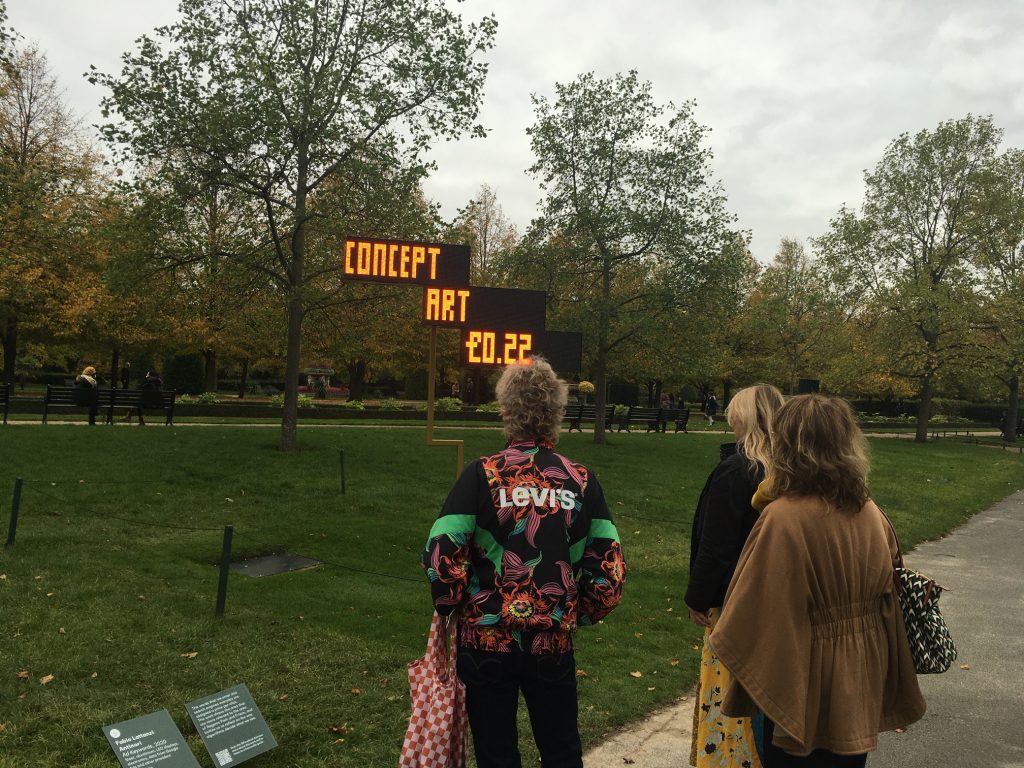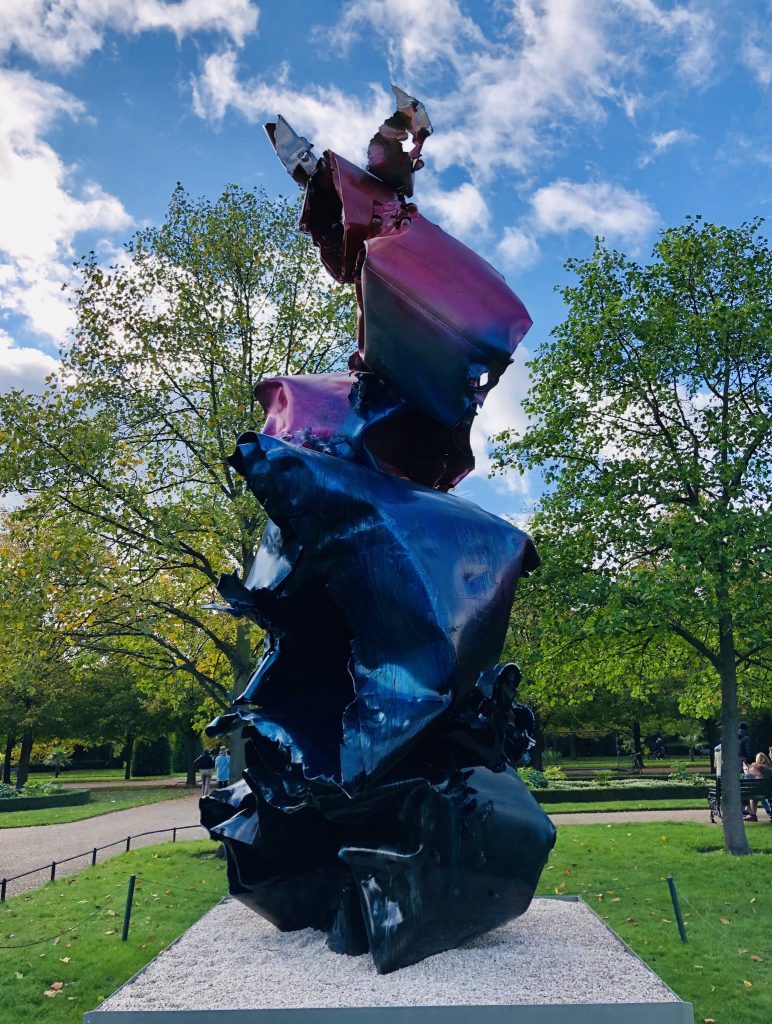With a mostly-virtual Frieze London and Frieze Masters this year, Frieze Sculpture was a welcome in-person event, featuring 12 large-scale physical sculptures, including new commissions from artists Arne Quinze, Kalliopi Lemos and Patrick Goddard. The public response was extraordinary, with large crowds heading to the English Garden in Regent’s Park to enjoy Clare Lilley’s careful and considered curation.
“Rarely have our public spaces been quite so important for our mental and physical well-being, and this exhibition shines a light on sculpture in the open air, creating a place of inspiration and enjoyment”, said Clare Lilley, Curator of Frieze Sculpture and Director of Programme, Yorkshire Sculpture Park.
Has COVID-19 allowed us to rediscover the delights of the sculpture park as a non-claustrophobic place of creativity, spontaneity and encounter? It seemed that this year would be about technology, immersive and interactive work and ticketed exhibitions in non-gallery spaces. Yet, across the UK, audiences continue to make time to see physical, dynamic and tactile artworks made of stone, wood, plastic, metal, glass and concrete on the urban trail of The Line, featured as part of Sculpture in the City inside the City of London, at Yorkshire Sculpture Park, at Houghton Hall in Norfolk and, most recently, at Frieze Sculpture.
Reflecting on these questions, Futurecity Curator Chloe Stagaman sat down with Curator Dr Jean Wainwright to discuss the lasting qualities of sculpture.
—Mark Davy, CEO, Futurecity Ltd.

Chloe Stagaman: In 2020, why the enduring captivation of material sculpture in an increasingly virtual world?
Dr Jean Wainwright: Now more than ever, as the ‘Do Not Touch’ rule and COVID restrictions have changed how people both behave and relate to the outside world, the sheer joy of a physical sculpture is really important. We need our senses to be stimulated and sculpture can make us think differently about a space or landscape whether permanent or temporary.
What intrigues people is when they can interact with the experience beyond the Instagram or social post—when there is that multi-layered background both to what an artist has made before and a unique response to a particular physical site.
Sculpture is such a physical medium and, although you can capture it virtually with 3D animation on a screen or even use haptic technologies, the effect is not the same. There is something about the scale and materiality of a sculpture in the landscape, exhibition, museum or working space that gives it the physical framing and frisson that is not available in the electronic image.

Chloe Stagaman: At this particular moment while we’re grappling with COVID-19, outdoor public spaces at which we can view sculpture in both urban and in landscape settings have become increasingly important. How might this will influence the ways in which makers or sculptors approach their work?
Dr Jean Wainwright: Rachel Whiteread, once famously described certain public sculptures as ‘plop’ sculpture: placed on a site without consideration of context, performance, audience motives. But makers have always been inventive in how they approach place and site and this will not change. I remember vividly a number of conversations with Richard Wilson about his thoughts when first conceiving of his monumental ‘Slipstream’ sculpture installed in Terminal 2 at Heathrow Airport. Wilson became intrigued with the Futurists and the idea of animation—how a couple of lines could convey the arc of a kicked ball, or a car skidding on the road.
Sculpture is often about collaboration and the gestation of ideas and the end result: The site where it is going to be sited or shown. Sculpture can also change with political events. As we return to communal outdoors spaces, it will be important to instil a sense of creative interaction with sculptures both physically and mentally that can grow with us.

Chloe Stagaman: Frieze Sculpture this year featured two different interpretations of doors by Lubaina Himid and Gavin Turk. What relevance does the door as a symbol have right now?
Dr Jean Wainwright: With Turk’s work there is so much irony: Starting with the play on words with the title, L’Age d’Or or ‘golden age’, a time of harmony and stability, and its literal sound in English as ‘large door’. It also references a famous L’Age d’Or surrealist film by Luis Buñuel which comments on the insanity of life. L’Age d’Or welcoming us to Frieze Sculpture is poignant. Here we start at an oversized door, half open and half shut, as we enter Tier Two in London.
Lubaina Himid’s Five Conversations depicts colourful portraits of women painted on reclaimed wooden doors taken from Georgian townhouses. Again, there are so many readings that this can have as to the Georgians and their relationship in Britain to Black history and colonialism. The brightly dressed figures speak to distinct identities and histories. I also noted how the human-scale doors were placed in configurations of three and two and how audiences in their ‘bubble groups’ seemed to echo the configuration while viewing. The doors unfolded like a labyrinth, inviting audiences to walk through and explore perspectives within. This conflation of theatre and feminism is very important to Himid’s work and really seemed to speak to the viewing audiences and invite participation and procession.
Visiting the sculpture park on a rare sunny October day and seeing people play visually with these doors, ‘opening and closing’ them metaphorically with their movements and gestures, I was struck by what the doors mean and what they allow: a type of passage at a time of otherwise closed doors. Post-lockdown, we could see the sculptures with fresh eyes after being deprived. The late artist Christo used to talk about this, about this re-learning to see and appreciate our spaces with new eyes.

Chloe Stagaman: In addition to your work as a curator and author, you are an educator and the Director of the Fine Art and Photography Research Centre at the University for the Creative Arts. What have your students uniquely taught you about the future of art and sculpture in 2020?
Dr Jean Wainwright: There are already COVID responses to making work, but generally artists want to make work that is integral to the way they have always worked. No one wants a trite and instant response. In this way the shift to online portfolios has benefitted some more than others. Our students did not have a physical show this year, so they were encouraged to think about the online site as the space. Some responded by thinking about gaming technology, and two of my ex-students Umut Gunduz and Anna Skutely, for example, created a playable game for Margate NOW 2020 which allowed visitors to explore virtual versions of various kebab restaurants in Margate through a mobile kebab map.

Frieze Sculpture was on view at Regent’s Park’s English Gardens from 5-18 October and featured 12 works by David Altmejd, Fabio Lattanzi Antinori, Gianpietro Carlesso, Eric Fischl, Patrick Goddard, Lubaina Himid, Kalliopi Lemos, Richard Long, Sarah Lucas, Gavin Turk, Rebecca Warren and Arne Quinze. Cover image: Richard Long, Circle for Sally (2016). Photos courtesy Futurecity Ltd.
See more information about Futurecity’s Public Art Projects
